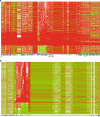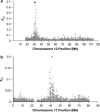Haplotype structure in Ashkenazi Jewish BRCA1 and BRCA2 mutation carriers
- PMID: 21597964
- PMCID: PMC3196382
- DOI: 10.1007/s00439-011-1003-z
Haplotype structure in Ashkenazi Jewish BRCA1 and BRCA2 mutation carriers
Abstract
Three founder mutations in BRCA1 and BRCA2 contribute to the risk of hereditary breast and ovarian cancer in Ashkenazi Jews (AJ). They are observed at increased frequency in the AJ compared to other BRCA mutations in Caucasian non-Jews (CNJ). Several authors have proposed that elevated allele frequencies in the surrounding genomic regions reflect adaptive or balancing selection. Such proposals predict long-range linkage disequilibrium (LD) resulting from a selective sweep, although genetic drift in a founder population may also act to create long-distance LD. To date, few studies have used the tools of statistical genomics to examine the likelihood of long-range LD at a deleterious locus in a population that faced a genetic bottleneck. We studied the genotypes of hundreds of women from a large international consortium of BRCA1 and BRCA2 mutation carriers and found that AJ women exhibited long-range haplotypes compared to CNJ women. More than 50% of the AJ chromosomes with the BRCA1 185delAG mutation share an identical 2.1 Mb haplotype and nearly 16% of AJ chromosomes carrying the BRCA2 6174delT mutation share a 1.4 Mb haplotype. Simulations based on the best inference of Ashkenazi population demography indicate that long-range haplotypes are expected in the context of a genome-wide survey. Our results are consistent with the hypothesis that a local bottleneck effect from population size constriction events could by chance have resulted in the large haplotype blocks observed at high frequency in the BRCA1 and BRCA2 regions of Ashkenazi Jews.
Figures





References
-
- Antoniou AC, Beesley J, McGuffog L, Sinilnikova OM, Healey S, Neuhausen SL, Ding YC, Rebbeck TR, Weitzel JN, Lynch HT, Isaacs C, Ganz PA, Tomlinson G, Olopade OI, Couch FJ, Wang X, Lindor NM, Pankratz VS, Radice P, Manoukian S, Peissel B, Zaffaroni D, Barile M, Viel A, Allavena A, Dall'olio V, Peterlongo P, Szabo CI, Zikan M, Claes K, Poppe B, Foretova L, Mai PL, Greene MH, Rennert G, Lejbkowicz F, Glendon G, Ozcelik H, Andrulis IL, Thomassen M, Gerdes AM, Sunde L, Cruger D, Birk Jensen U, Caligo M, Friedman E, Kaufman B, Laitman Y, Milgrom R, Dubrovsky M, Cohen S, Borg A, Jernstrom H, Lindblom A, Rantala J, Stenmark-Askmalm M, Melin B, Nathan-son K, Domchek S, Jakubowska A, Lubinski J, Huzarski T, Osorio A, Lasa A, Duran M, Tejada MI, Godino J, Benitez J, Hamann U, Kriege M, Hoogerbrugge N, van der Luijt RB, Asperen CJ, Devilee P, Meijers-Heijboer EJ, Blok MJ, Aalfs CM, Hogervorst F, Rookus M, Cook M, Oliver C, Frost D, Conroy D, Evans DG, Lalloo F, Pichert G, Davidson R, Cole T, Cook J, Paterson J, Hodgson S, Morrison PJ, Porteous ME, Walker L, Kennedy MJ, Dorkins H, Peock S, Godwin AK, Stoppa-Lyonnet D, de Pauw A, et al. Common Breast Cancer Susceptibility Alleles and the Risk of Breast Cancer for BRCA1 and BRCA2 Mutation Carriers: Implications for Risk Prediction. Cancer Res. 2010;70:9742–9754. doi: 10.1158/0008-5472.CAN-10-1907. - PMC - PubMed
-
- Atzmon G, Hao L, Pe'er I, Velez C, Pearlman A, Palamara PF, Morrow B, Friedman E, Oddoux C, Burns E, Ostrer H. Abraham's children in the genome era: major Jewish diaspora populations comprise distinct genetic clusters with shared Middle Eastern Ancestry. Am J Hum Genet. 2010;86:850–859. - PMC - PubMed
-
- Barrett JC, Fry B, Maller J, Daly MJ. Haploview: analysis and visualization of LD and haplotype maps. Bioinformatics. 2005;21:263–265. - PubMed
Publication types
MeSH terms
Substances
Supplementary concepts
Grants and funding
- RC4 CA153828/CA/NCI NIH HHS/United States
- 11174/CRUK_/Cancer Research UK/United Kingdom
- C5047/A8385/CRUK_/Cancer Research UK/United Kingdom
- CA- 06-503/CA/NCI NIH HHS/United States
- 11022/CRUK_/Cancer Research UK/United Kingdom
- R01 CA128978/CA/NCI NIH HHS/United States
- CA116167/CA/NCI NIH HHS/United States
- R01 CA116167/CA/NCI NIH HHS/United States
- ZIA BC011301/ImNIH/Intramural NIH HHS/United States
- C1287/A11990/CRUK_/Cancer Research UK/United Kingdom
- 10118/CRUK_/Cancer Research UK/United Kingdom
- C1287/A10118/CRUK_/Cancer Research UK/United Kingdom
LinkOut - more resources
Full Text Sources
Medical
Molecular Biology Databases
Research Materials
Miscellaneous

